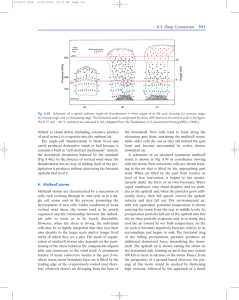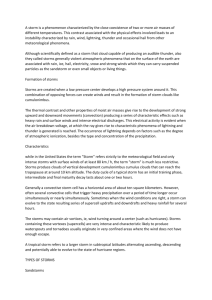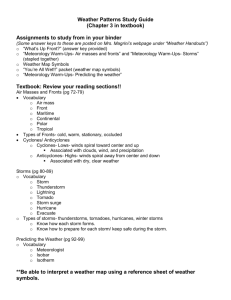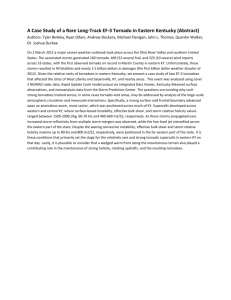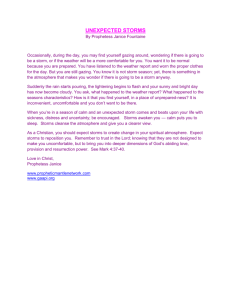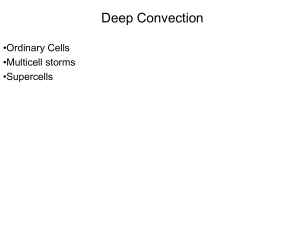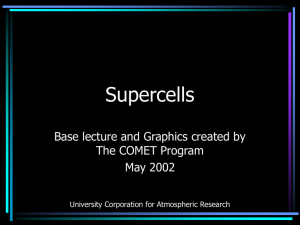Storm Type - Iowa State University
advertisement
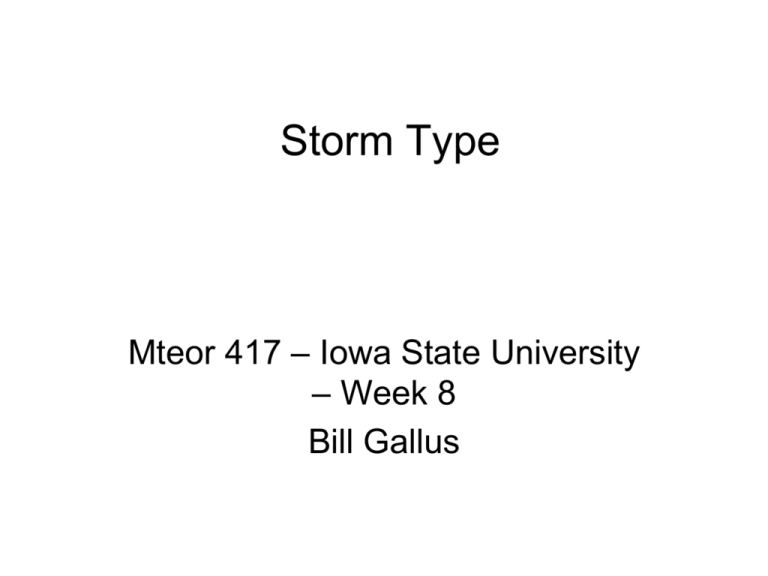
Storm Type Mteor 417 – Iowa State University – Week 8 Bill Gallus Three Major Types of Storms • Single Cell • Multicell • Supercell Single Cell (Ordinary Cell) • A) Forecasting Hints 1. Generally occur with instability (CAPE > 1000 J/kg) and a lack of other NORMAL severe weather parameters like shear or forcing 2. Weak wind shear/random hodographs 3. May occur with inverted-V soundings 4. Common during warmer, more humid months of year over much of US (anywhere atmosphere is unstable) Single Cells • B) Severe Potential 1. Can cause “pulse” severe with large hail and damaging winds 2. Tornadoes almost NEVER happen 3. Because severe intensity is so random and brief, very difficult to warn much in advance 4. Inverted-V sounding might be best indicator for microburst severe winds if storms form Single Cells • C) Structure 1. Has a three stage life-cycle a) Towering Cumulus Stage (upward motion everywhere, any precip is suspended aloft) b) Mature Stage (rain core develops and falls to ground, downdraft and updraft exist side-by-side c) Dissipating Stage (entire storm rains out, downdraft everywhere) Images taken from Lyndon State College web site Single Cells 2. Entire lifetime is only 30-60 minutes 3. Peak updraft speed usually around 10 m/s Multicell (can be organized into bow echoes, derechoes, squall lines, and nonlinear events) A) Forecasting Hints 1. Occur with moderate to high instability (CAPE > 1500 J/kg) 2. Moderate wind shear, mostly due to speed changes and not directional ones (0-6km shear vectors < 35-40 knots) 3. Hodograph is a straight line 4. If a cyclone gets too “wound up” or occluded, and flow at all levels is from roughly same direction, multicells dominate over supercells Multicells B) Severe Potential 1. Large hail rather common (usually < 2 inches in diameter) 2. Strong wind gusts (can > 100 mph in derechoes) 3. A few tornadoes may occur, but they are usually weak and only found in parts of multicell systems having enhanced horizontal shear Multicells C) Structure 1. Organized clusters of at least 2-4 short-lived cells 2. Each cell generates a cold outflow, and the outflows combine to form large gust front 3. Convergence on gust front helps create new cells every 5-15 minutes, usually on south end of system 4. Storms move with mean wind, but area motion will appear to deviate significantly due to DISCRETE PROPAGATION (new cells form along gust front) 5. Lifetime can be many hours, although individual elements within multicell have short lifetimes DISCREET PROPAGATION Mean wind Storms follow mean wind toward east, but as they go through their short lives, new storms are preferentially forming to the south so that the “SYSTEM” movement appears to be toward the southeast. Multicells D) Organizations of multicells 1. DERECHO: classic, straight-line wind storm, occurs with very strong speed shear, often in a “ring-of-fire” zone. Can be very long-lived and travel quickly over long distances Progressive Derechoes • CAPE > 4000 J/kg (even after dark), with LI < -8 • W to NW flow • Warm advection induced over weak frontal boundary • Upper-level jet streak/transient weak short wave • Rapid propagation > 40 knots or Warm front or other boundary Serial Derechoes • Less instability (LI -4 to -8, CAPE 1500-3000 J/kg) • 700 mb winds > 50 knots STRONGER • 500 mb winds > 70 knots DYNAMICS • Straight-line hodographs L H Derecho paths (from Stu Ostro, Weather Channel) during 1995 – around the ring of fire subtropical high located over the Midwest leading to a heat wave Multicells D) Organizations of multicells 2. BOW ECHO: Can also contain supercells, has a distinct bow shape. Strongest winds are where echo moves fastest Fairly large-scale bow echo, from a wikipedia site Multicells 3. SQUALL LINE: Can be extremely large area of multicell convection, with strongest storms in line, and big areas of steady “stratiform” rain behind them. Squall line extending from southern Missouri into northwestern Mississippi Supercells (include classic, HP, LP) A) Forecasting hints 1. Moderate to high instability (CAPE >1500 J/kg) 2. Moderate or strong speed and directional shear (0-6km shear vector > 35-40 knots) 3. Hodographs have lots of curvature in lowlevels (usually true but not always) Supercells B) Severe Potential 1. Large to extreme hail (“softballs”) 2. Damaging wind gusts (due to various storm-scale jets) 3. Biggest producer of tornadoes (especially violent ones) Supercells C) Structure 1. Consists of one quasi-steady rotating updraft 2. Can form as a multicell initially 3. Initially may move with the mean wind, but generallly they move to the right of the mean wind at a slower speed 4. Combination of strong CAPE and shear creates perturbation pressure fields which produce the rotation, longevity and rightward drift Supercells 5.Storm-splitting occasionally occurs into a leftmoving and right-moving storm. Although both can produce severe weather, the right-moving one usually becomes more intense 6. FLANKING LINE of towering cumulus generally occurs on the right flank of storm 7. Base of the updraft is marked by a lowered, slowly rotating nearly precipitation-free cloud base called a WALL CLOUD Supercells 8. TAIL CLOUD may form, feeding into the wall cloud from the precipitation core, which is usually off to the N or NE 9. WALL CLOUD generally has a smooth, stratuslike appearance 10. Smooth striations may also appear in midlevels around the storm cloud – a good indicator of rotation 11. OVERSHOOTING TOP usually appears above the anvil top. This indicates the strongest, most active updraft, and is often above the area where the tornado will form (although things may be tilted some) Supercells 12. Storm may have a greenish appearance due to hail and the lack of precipitation in the updraft 13. Upward motion can exceed 50 m/s 14. Tornadoes generally form under the wall cloud 15. Mammatus clouds may be seen on underside of anvil mammatus striations Flanking Line Tail cloud Supercells D) Variations of Supercells 1. CLASSIC: produces standard hook echo radar echo. It has a substantial rain core that is slightly removed from main updraft region of storm where wall cloud is located. This type of storm allows the tornadoes to be seen from some distance if off to the right of the direction toward which storm is moving. “Classic” Supercell Thunderstorm Supercells D) Variations of Supercells 2. HP (High-Precipitation): Rain falls much closer to the tornado, effectively making it hard to see. Now believed that stormrelative winds at 9-10 km level determine types of supercells. HP occur if these winds are < 20 m/s High-precipitation Supercell Supercells D) Variations of Supercells 3. LP (Low-precipitation): Usually occurs near dry line. Except for some very large hail, there is little precipitation in these storms, except several km downstream. Storm structure can be easily seen – and sometimes called in as UFOs. Tornadoes are not as common. LP sups are likely if the 9-10 km SR wind > 30 m/s. LP-Classic-HP • Also the supercell type may be affected by “seeding” from upstream storms. If storms develop upstream (usually SW or W), and their anvil clouds are streaming into another storm, then that storm will NOT be an LP, but instead will turn into a classic or, more likely, and HP, since the ice from the interfering anvil will create more rain close to the circulation center. • Thus, any storm will be “wetter” if “seeded” Low-Precipitation Supercell How can you determine most likely storm type for an area? A) First determine the entire region where any storms could occur, concentrating on instability (in summer, this can cover much of USA) 1. Look at some soundings 2. Look for regions of fairly high temperature and dew point and sufficient moisture at 850 mb 3. Eliminate areas too warm at 700 mb (cap) 4. Check 500 mb temperatures and include areas that seem “cool” compared to sfc temp/dew points. If 85/65 at surface, -10 C may be needed at 500 mb. If 70/55 at surface, may need -16C or colder aloft. 5. If all of these factors look good, airmass thunderstorms could develop, even without noticeable forcing mechanisms, as long as there aren’t any strong downwardmotion forcing mechanisms, like NVA or being directly beneath a synoptic high. 6. If not all parameters look good, be careful in areas of STRONG FORCING, due to strong PVA or along fronts, because the forcing can overcome some deficiencies. B) Check winds over your thunderstorm potential area… 1. IF winds are fairly strong at most levels AND some type of forcing exists to trigger storms, potential for MULTICELL or SUPERCELL increases 2. If wind shear is mostly due to speed changes and not direction AND speeds are typically < 30 knots, MULTICELLS are favored. 3. If wind shear includes significant veering with height, and winds > 35 knots at least at one level from 500 mb to the surface, SUPERCELLS are possible
